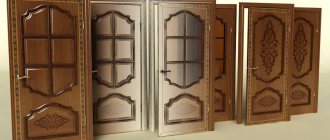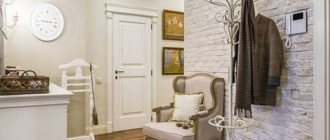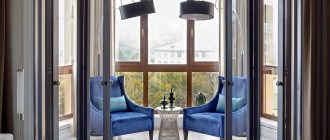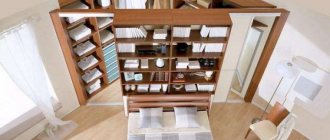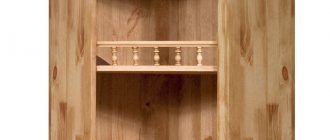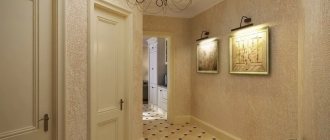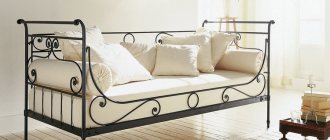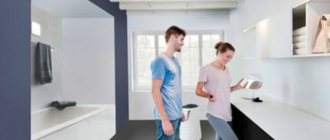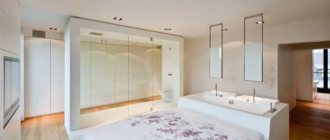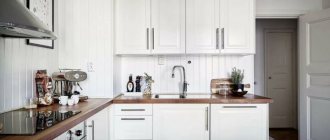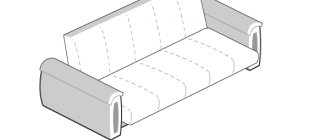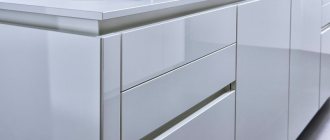What are panel doors?
To explain it simply, a paneled door model is a canvas made of individual parts (panels) inserted into a frame. Depending on the materials from which the structure is made, there are two main types of such canvases:
- External. Either metal or a variety of dense wood is used. As a rule, such canvases also have an appropriate weight.
- Internal, room. Lighter both in weight and in the materials used - thin wood, MDF, plywood, glass.
The main feature is the ability to select a wide variety of panels in shape, color, material, pattern, volume and pattern. If you are tired of the design, if you have changed the interior, you can simply replace the parts to qualitatively change the appearance. In other cases, it is not even necessary to change the panels. If they are glass, then a pattern or drawing is applied to the surface with acrylic paints, and a film with a photograph, painting or other image is glued on.
Parts processing
We cut the boards with an allowance of at least 10 cm to the required length of the board. This can be done manually, on a circular or miter saw. After this, they must be carefully planed along the sides and edges. You can perform this stage of work yourself with a hand plane or jointer, but it is better to use mechanical devices - an electric planer or a jointer. After processing, the edges of the parts must be strictly perpendicular to the faces and have a rectilinear shape without depressions or humps.
The ideal tool for preparing parts for subsequent gluing is a thickness planer. They come in one, two, and four sides. The best and most expensive are representatives of the last group of instruments. After thicknessing, the edges will be ideal in shape and strictly parallel to each other.
Parts processing
Advantages and disadvantages
Paneled doors are becoming popular for a reason. They are chosen because of their undeniable advantages:
- For such a canvas it is not difficult to carry out independent restoration.
- Aesthetic appearance, universal design.
- Light weight. Since the canvas is not made from a single sheet of wood, but from separate inserts, this significantly reduces its overall weight.
- Paneled doors are much more practical than solid wood models (especially those made from inexpensive types of material). The fact is that natural wood responds negatively to sudden changes in temperature and an increase in air humidity in the room - it swells, becomes deformed, and cracks when it dries.
Interestingly, paneled models have no specific disadvantages. If there are complaints, then they relate more to specific unscrupulous manufacturers, and not to the design itself.
Dimensions
There are standards for door sizes in the Russian Federation, this is GOST 6629-88. According to these standards, there are several types of height and width of the door frame:
- height: 2071 mm; 23721 mm;
- width: 670 mm – 970 mm, 1170 mm, 1172 mm, 1472 mm, 1872 mm.
The dimensions of the door leaf must also comply with the following standards:
- height: 2000 mm and 2300 mm;
- width: 600 mm, 700 mm, 800 mm, 900 mm, 1100 mm; as well as 2*600 mm, 2*700 mm, 2*900 mm.
Design Features
The door panel is disassembled into several components:
- upper beam of horizontal (transverse) strapping;
- frame strapping;
- frame binding;
- pillar elements;
- middle beam of horizontal strapping;
- the panel itself;
- the lower beam of the horizontal strapping.
paneled door design
Of these, it is necessary to highlight three main “pillars” of the design:
- Frame (another name is harness). Acts as the basis of the entire structure. It is to this element that the panel parts are attached through grooves. Depending on the model you choose, the frame is made of either solid wood or individual pieces glued together. In many paneled fabrics, the binding is divided into four parts. Of these, the lower component is the most massive and wide, because the entire structure actually rests on it. If you are purchasing a paneled exterior door, the bottom of the frame may be lined with galvanized steel or aluminum sheeting to provide additional protection.
- Middle bars. These are horizontal elements located across the door leaf.
- The panels themselves. An important decorative component, fixed in the frame of the structure. They are made not only from MDF and plywood, but also glass and plastic.
Design
Paneled doors are made in any designs and styles. Thanks to the extensive range, it is possible to choose a product for any type of room. For residential premises, doors with glass or transparent inserts are chosen. They can be decorated with painting (classical or modern patterns) or photo printing. For the bathroom and toilet room, the ideal solution would be a door leaf with blind slats.
Panels in interior doors are:
- straight;
- curly;
- with additional pads;
- with volumetric elements;
- with elaborate carvings and relief.
Doors with a glass panel can be transformed yourself by applying a design to it and turning it into a stained glass window.
Materials
Depending on the main material from which the door model was made, three groups are distinguished:
- Structures made from valuable tree species. The assembled fabric is treated with antiseptics and solutions that provide fire-fighting properties.
- Coniferous wood structures.
- Structures made of combined materials. The price is even more affordable. The most common here is the use of a frame (frame) made of pine timber, panel elements made of MDF panels, laminated or veneered plywood sheets. For reliability, the surface of the product is treated with protective impregnations. But their properties are only sufficient to use such canvases as interior decorations.
Colors
Manufacturers produce wooden paneled panels in a wide range of colors. All wooden frames of the models are impregnated with antiseptic compounds and solutions that suppress the occurrence of fungus. Finishing of products is carried out using varnish. It will retain the attractiveness of natural wood.
Some models are coated with enamels and paints. The most common are light milky and beige shades. White doors have gained massive popularity in the domestic market. They are able to visually enlarge the space, make the room “light” and “airy”.
Main types of panels
Paneled doors are also divided according to the types of elements from which they are composed - panels. If you look at the shape of the parts and fastening options, five groups stand out:
- Flat. The simplest variety in the category. The panel is a part made of thin material that does not have any protrusions, cutouts or decorative elements.
- Typesetting. Each panel itself is a prefabricated element consisting of several lamellas. These parts, in turn, are attached to each other using a tongue-and-groove method.
- Volumetric. The most popular type. These are three-dimensional figures that are pre-processed using milling.
- Figareynaya. It is called an insert with thickened edges that become thinner only as they approach the edge of the element. Such panels can be secured to grooves. For reliability, they are also treated with wood glue.
- Floating With this manufacturing method, the craftsman deliberately leaves gaps around the perimeter of the part - this is required so that under the influence of high humidity, temperature changes, when wooden parts change their shape and volume, there is no harm to the entire structure or distortion of the canvas. The floating panels are secured inside the frame using glazing beads.
In addition to this classification, panel elements differ in color and type of wood. It is the latter characteristic that greatly influences the cost of the door structure, the time of its manufacture, and the duration of operation.
production of panel doors
Details
Manufacturing materials
There are paneled door panels that are designed for use inside rooms, and there are also options that can be used as exterior doors. Both types have noticeable differences in the material of manufacture. Interior doors are made from bars and thin boards with different color categories:
- Exotic, for example, rosewood, wenge or even Karelian birch.
- Deciduous, for example teak, walnut, elm, beech or oak.
- Conifers (cedar, spruce, pine).
Such products are called solid wood doors, which are quite heavy and durable, and also provide ideal sound insulation and are quite expensive. Processing a wooden surface is usually carried out in several stages:
- A primer composition that is applied in 2 layers to obtain the ideal shade.
- Treatment with a two-component paint and varnish composition, which has protective and decorative functions.
In most cases, wooden parts are combined with lightweight materials - chipboard, fiberboard and MDF. In order to increase the service life of the combined door, they are laminated and a PVC film is applied, which will protect porous wood substitutes from the influence of atmospheric moisture. Often these doors are hollow, or filled with all sorts of fillers - chipboard, wooden blocks and corrugated cardboard. To obtain the most noble appearance, doors are often treated with veneer, which is a thin (0.2 to 0.3 cm) cut of natural wood of valuable species. Veneer has a color and texture that is indistinguishable from solid wood, and is also fixed with all kinds of wood glue.
Occasionally, plastic panels (i.e. panels) are used in interior panel doors, which are called environmentally friendly veneer, which is used to trim bases made of relatively inexpensive wood. Moreover, the front part of such panels is usually made with an imitation of wood structure, and to enhance the effect they are covered with polypropylene film with a beautiful pattern. Such “hybrids” are installed in rooms with high humidity, for example, in a swimming pool, bathroom or greenhouse. Entrance doors are made from thicker solid wood, and metal overlays are often used for reinforcement. Quite often the frame is made entirely of metal, and is decorated with wood panels.
Dimensions
There are standards for door dimensions in Russia, or more precisely, GOST 6629-88. For such holes, there are different options for the width and height of the door frame:
- Width - from 0.67 to 0.97 meters, as well as 1.17, 1.172, 1.472 and 1.872 meters.
- Height – 2.071 and 23.72 meters.
The dimensions of the door leaf must comply with the following standards:
- Width – 0.6, 0.7, 0.8, 0.9, 1.1 meters, and also 0.2*60, 0.2*70 and 0.2*90 cm.
- Height 2 and 2.3 meters.
And now about the shades.
Color spectrum
The variety of color solutions depends on the manufacturer. The more natural the materials used to create the door, the more the manufacturer wants to preserve the natural wood grain, regardless of whether it is solid wood or even natural veneer. The following colors have become standard:
- Sapele.
- Red tree.
- Double black.
- Oregano.
- White.
- Wenge.
- Walnut (golden, nougat, light or Milanese).
- Oak (white, stained, wenge, with patina in the colors “baked milk”, “Oxford”, “white patina”, natural and gray).
And now about the manufacture of panel doors.
Decorative door trim
As for the finishing of these structures, it begins with antiseptic treatment. The application of disinfectant compounds prevents the spread of fungus, mold, and premature aging of natural wood. Sometimes drugs are added to the antiseptic to make the treated surface fire-resistant.
Also, at the initial stages of finishing, wood is often painted with special pigments. The purpose of this processing is to make the shade of the natural material more saturated, pronounced and bright. A number of manufacturers of panel doors work on pre-order: the buyer can choose the shade in which his purchase will be painted. But when choosing painted models, remember that the dye is applied only to the outer, upper surface and does not penetrate deep into the wood. Therefore, mechanical action leaves a mark, a scratch on the canvas, revealing the true color.
The final treatment of the structure is the application of acrylic varnish. It is distinguished from less modern materials by its environmental friendliness and insignificant impact on the shade of the wood surface. If you purchase a paneled model with glass elements, then it goes through the next stage of decorative finishing - the application of stained glass paintings, varied in color and virtuosity of execution.
varnishing the door
In carpentry, there are two types of finishing, design of canvas with panels:
- Same type, solid. The frame and paneled elements are of the same shade and texture.
- Contrasting. The trim and panel parts are of different colors, which does not prevent the entire structure from looking harmonious and complete.
Another finishing point that is important to pay attention to when purchasing is the type of decorative coating:
- Glossy. More practical - abrasions, scratches, and small stains are less noticeable on it. But the gloss hides the beauty of the pattern of natural wood.
- Matte. The aesthetic appearance does not last long - damage and dirt will be noticeable.
Installation
Installing a door involves performing the following steps:
- leveling and plastering of door slopes;
- fixing wooden planks;
- screwing the aluminum guide into the upper door frame;
- placing the leading part of the leaf at a minimum distance to the door jamb with fastening to the floor (bottom) and to the guide (top);
- connecting the driven leaf to the leading leaf (using hinges);
- fixing the driven part in the guide (use a carriage equipped with rollers);
- installation of limiters (the sashes should not touch the surface of the walls);
- lubrication of mechanisms with an oil composition.
Installation of a book door with hanging elements is carried out as follows. After leveling the slopes, extensions are made from MDF panels, which are fixed in the opening using dowels. The space between the extensions and the wall is sealed with polyurethane foam.
Installation of hanging elements is carried out:
- an aluminum rail in a strictly horizontal position crashes into the upper part of the door frame;
- a carriage on rollers is inserted into the rail groove, which should move without interference;
- limiters are mounted in the extreme part of the rail;
- attaching the carriage to one leaf;
- lubrication of metal structural elements.
If a heavy door is being installed, then you should additionally consider installing a floor system with a roller mechanism. The aluminum rail is being installed into the floor. A carriage with a roller mechanism, which is connected to the bottom of the sash, is inserted into the rail.
The door moves along guides using sliders. Self-tapping screws are used to fasten the guides. The book is closed using handles and latches.
How to choose a paneled door
When choosing panel fabric, first of all, be guided by your own taste and interior features. However, preference should still be given to reliable manufacturers - today the integrity of any factory can be easily verified by monitoring several sites with independent reviews.
If you are interested in buying economy-class canvas, then stop at MDF models - they are the most reliable. Moreover, the material is less vulnerable to humidity and temperature changes, which is why it is sometimes more durable than natural wood.
Door care rules
To ensure that your purchase pleases you with its beautiful appearance, it is enough to follow the care recommendations:
- Do not use various aggressive, abrasive chemical solutions to clean the surface.
- If you notice severe contamination on the canvas, prepare an alcohol solution in a ratio of 1:10. moisten a cotton swab and wipe the stain. Then rinse with water, dipping a soft cloth in it. Wipe dry with a clean cloth.
- Use only soft and absorbent cloths and napkins to care for the surface. Moisture left on the surface of natural wood can change its shape and color.
- If you bought a varnished, glossy panel door, be prepared for the fact that without proper care it will become dull and cloudy with use. To prevent this from happening, the surface is treated from time to time with wax or special polishes.
- If the door has glass inserts, use the same spray to care for them as for mirrors and window glass. Cover adjacent surfaces with mounting tape to prevent the product from getting on them.
- Do not forget also about caring for locks and hinges - they need periodic lubrication.
